Garmin Beechcraft 58, G58 Reference Guide

G1000TM
Cockpit Reference Guide for the Beechcraft 58/G58
Copyright © 2005 Garmin Ltd. or its subsidiaries. All rights reserved.
This manual reflects the operation of System Software version 0500.00 or later for the Beechcraft 58/G58. Some differences in operation may be observed when comparing the information in this manual to earlier or later software versions.
Garmin International, Inc., 1200 East 151st Street, Olathe, Kansas 66062, U.S.A.
Tel: 913/397.8200 |
Fax: 913/397.8282 |
GarminAT, Inc., 2345Turner Road SE, Salem, OR 97302, U.S.A. |
|
Tel: 503/391.3411 |
Fax 503/364.2138 |
Garmin (Europe) Ltd., Unit 5,The Quadrangle,Abbey Park Industrial Estate, Romsey, Hampshire S051 9DL, U.K. |
|
Tel: 44/0870.8501241 |
Fax: 44/0870.8501251 |
Garmin Corporation, No. 68, Jangshu 2nd Road, Shijr,Taipei County,Taiwan |
|
Tel: 886/02.2642.9199 |
Fax: 886/02.2642.9099 |
Web SiteAddress: www.garmin.com
Except as expressly provided herein, no part of this manual may be reproduced, copied, transmitted, disseminated, downloaded or stored in any storage medium, for any purpose without the express written permission of Garmin. Garmin hereby grants permission to download a single copy of this manual and of any revision to this manual onto a hard drive or other electronic storage medium to be viewed for personal use, provided that such electronic or printed copy of this manual or revision must contain the complete text of this copyright notice and provided further that any unauthorized commercial distribution of this manual or any revision hereto is strictly prohibited.
Garmin® is a registered trademark of Garmin Ltd. or its subsidiaries, and G1000™ is a trademark of Garmin Ltd. or its subsidiaries. These trademarks may not be used without the express permission of Garmin.
NavData® is a registered trademark of Jeppesen, Inc.; Stormscope® and SkyWatch® are registered trademarks of L-3 Communications; and XM® is a registered trademark of XM Satellite Radio, Inc.;
October 2005 |
190-00526-00 Rev.A |
Printed in the U.S.A. |
Garmin G1000 Cockpit Reference Guide for the Beechcraft 58/G58

WARNINGS,
CAUTIONS, & NOTES
WARNING: Navigation and terrain separation must NOT be predicated upon the use of the terrain function. The G1000 Terrain Proximity feature is NOT intended to be used as a primary reference for terrain avoidance and does not relieve the pilot from the responsibility of being aware of surroundings during flight. The Terrain Proximity feature is only to be used as an aid for terrain avoidance and is not certified for use in applications requiring a certified terrain awareness system. Terrain data is obtained from third party sources. Garmin is not able to independently verify the accuracy of the terrain data.
WARNING: The displayed minimum safe altitudes (MSAs) are only advisory in nature and should not be relied upon as the sole source of obstacle and terrain avoidance information. Always refer to current aeronautical charts for appropriate minimum clearance altitudes.
WARNING:The altitude calculated by G1000 GPS receivers is geometric height above Mean Sea Level and could vary significantly from the altitude displayed by pressure altimeters, such as the GDC 74A Air Data Computer, or other altimeters in aircraft. GPS altitude should never be used for vertical navigation. Always use pressure altitude displayed by the G1000 PFD or other pressure altimeters in aircraft.
WARNING: The Jeppesen database used in the G1000 system must be updated regularly in order to ensure that its information remains current. Updates are released every 28 days. A database information packet is included in the G1000 package. Pilots using an outdated database do so entirely at their own risk.
WARNING: The basemap (land and water data) must not be used for navigation, but rather only for nonnavigational situational awareness. Any basemap indication should be compared with other navigation sources.
WARNING: Traffic information shown on the G1000 Multi Function Display is provided as an aid in visually acquiring traffic. Pilots must maneuver the aircraft based only uponATC guidance or positive visual acquisition of conflicting traffic.
WARNING: Use of the Stormscope interface for hazardous weather penetration (thunderstorm penetration) is prohibited. Weather information on the G1000 MFD is approved only for weather avoidance, not penetration.
WARNING: Use of the GDL 69 Weather Interface for hazardous weather penetration is prohibited. Weather information provided by the GDL 69 is approved only for weather avoidance, not penetration.
ii |
Garmin G1000 Cockpit Reference Guide for the Beechcraft 58/G58 |
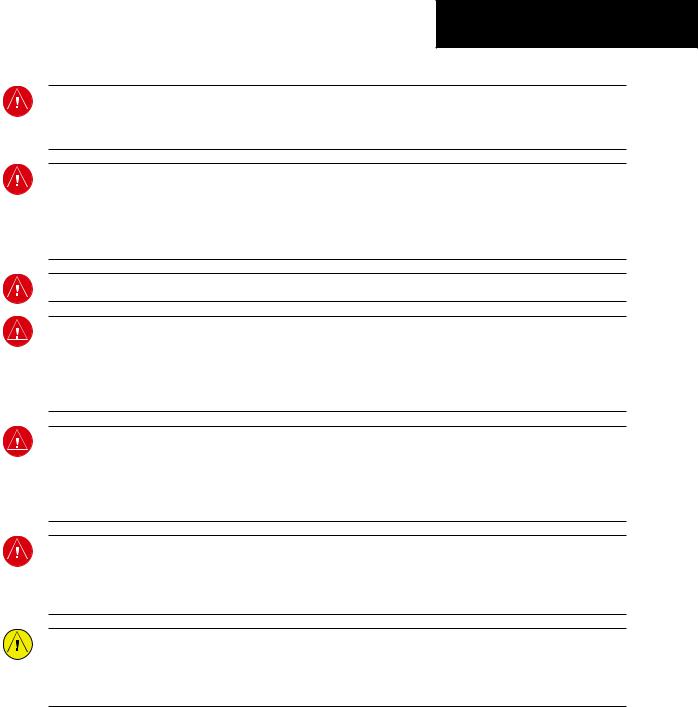
WARNINGS,
CAUTIONS, & NOTES
WARNING: NEXRAD weather data is to be used for long-range planning purposes only. Due to inherent delays in data transmission and the relative age of the data,NEXRAD weather data should not be used for short-range weather avoidance.
WARNING: The Garmin G1000, as installed in the Beechcraft 58/G58 aircraft, has a very high degree of functional integrity. However, the pilot must recognize that providing monitoring and/or self-test capability for all conceivable system failures is not practical. Although unlikely, it may be possible for erroneous operation to occur without a fault indication shown by the G1000. It is thus the responsibility of the pilot to detect such an occurrence by means of cross-checking with all redundant or correlated information available in the cockpit.
WARNING: For safety reasons, G1000 operational procedures must be learned on the ground.
WARNING: The United States government operates the Global Positioning System and is solely responsible for its accuracy and maintenance. The GPS system is subject to changes which could affect the accuracy and performance of all GPS equipment. Portions of the Garmin G1000 utilize GPS as a precision electronic NAVigation AID (NAVAID). Therefore, as with all NAVAIDs, information presented by the G1000 can be misused or misinterpreted and, therefore, become unsafe.
WARNING: To reduce the risk of unsafe operation, carefully review and understand all aspects of the G1000 Pilot’s Guide documentation and the Beechcraft 58/G58 Pilot’s Operating Handbook. Thoroughly practice basic operation prior to actual use. During flight operations, carefully compare indications from the G1000 to all available navigation sources, including the information from other NAVAIDs, visual sightings, charts, etc. For safety purposes, always resolve any discrepancies before continuing navigation.
WARNING: The illustrations in this guide are only examples. Never use the G1000 to attempt to penetrate a thunderstorm. Both the FAA Advisory Circular, Subject: Thunderstorms, and the Airman’s Information Manual (AIM) recommend avoiding “by at least 20 miles any thunderstorm identified as severe or giving an intense radar echo.”
CAUTION: The GDU 1040 PFD and GDU 1043 MFD displays use a lens coated with a special anti-reflective coating that is very sensitive to skin oils, waxes, and abrasive cleaners. CLEANERS CONTAINING AMMONIA WILL HARMTHEANTI-REFLECTIVE COATING. It is very important to clean the lens using a clean, lint-free cloth and an eyeglass lens cleaner that is specified as safe for anti-reflective coatings.
Garmin G1000 Cockpit Reference Guide for the Beechcraft 58/G58 |
iii |

WARNINGS,
CAUTIONS, & NOTES
CAUTION: The Garmin G1000 does not contain any user-serviceable parts. Repairs should only be made by an authorized Garmin service center. Unauthorized repairs or modifications could void both the warranty and the pilot’s authority to operate this device under FAA/FCC regulations.
NOTE:When using Stormscope,there are several atmospheric phenomena in addition to nearby thunderstorms that can cause isolated discharge points in the strike display mode. However, clusters of two or more discharge points in the strike display mode do indicate thunderstorm activity if these points reappear after the screen has been cleared.
NOTE: All visual depictions contained within this document, including screen images of the G1000 panel and displays, are subject to change and may not reflect the most current G1000 system. Depictions of equipment may differ slightly from the actual equipment.
NOTE: This device complies with part 15 of the FCC Rules. Operation is subject to the following two conditions:
(1) this device may not cause harmful interference, and (2) this device must accept any interference received, including interference that may cause undesired operation.
iv |
Garmin G1000 Cockpit Reference Guide for the Beechcraft 58/G58 |

RECORD OF REVISIONS
Part Number |
Change Summary |
190-00526-00 |
Initial release. |
|
|
Revision |
Date of Revision |
Affected Pages |
Description |
A |
10/3/05 |
i-Index-4 |
Initial release |
|
|
|
|
Garmin G1000 Cockpit Reference Guide for the Beechcraft 58/G58 |
v |

RECORD OF REVISIONS
This page intentionally left blank.
vi |
Garmin G1000 Cockpit Reference Guide for the Beechcraft 58/G58 |

TABLE OF CONTENTS
SECTION 1: SYSTEM OVERVIEW.................................... |
1-1 |
|
1.1 |
PFD/MFD Controls................................................... |
1-2 |
1.2 |
PFD Softkeys............................................................ |
1-4 |
1.3 |
MFD Softkeys.......................................................... |
1-7 |
1.4 |
MFD Page Groups................................................... |
1-8 |
1.5 |
Backlighting............................................................. |
1-8 |
SECTION 2: FLIGHT INSTRUMENTS.............................. |
2-1 |
|
2.1 |
Airspeed Indicator.................................................. |
2-3 |
|
Speed Indication ......................................................... |
2-3 |
|
Speed Ranges............................................................. |
2-3 |
|
AirspeedTrendVector ................................................. |
2-3 |
|
Vspeed References...................................................... |
2-3 |
2.2 |
Attitude Indicator.................................................. |
2-3 |
2.3 |
Altimeter.................................................................. |
2-4 |
|
Altitude Reference Bug................................................ |
2-4 |
|
AltitudeTrendVector................................................... |
2-4 |
|
Barometric Setting Box................................................ |
2-4 |
2.4 |
Vertical Deviation/Glideslope Indicator............ |
2-4 |
2.5 |
Marker Beacon Annunciations ............................ |
2-4 |
2.6 |
Vertical Speed Indicator....................................... |
2-5 |
2.7 |
Horizontal Situation Indicator (HSI)................... |
2-5 |
|
Course Pointer ............................................................ |
2-6 |
|
Course Deviation Indicator (CDI).................................. |
2-6 |
|
Bearing Pointers and InformationWindows.................. |
2-6 |
|
DME Radio (optional).................................................. |
2-7 |
|
Navigation Source....................................................... |
2-7 |
SECTION 3: ENGINE INDICATION SYSTEM (EIS).... |
3-1 |
|
3.1 |
Engine Display......................................................... |
3-1 |
3.2 |
Lean Engine Display............................................... |
3-1 |
3.3 |
Engine System Display.......................................... |
3-2 |
SECTION 4: NAV/COM AND TRANSPONDER.......... |
4-1 |
|
4.1 |
Radio Status Indications....................................... |
4-3 |
4.2 |
Volume...................................................................... |
4-3 |
4.3 |
Automatic Squelch................................................. |
4-3 |
4.4 |
Quickly Activating 121.500 MHz.......................... |
4-3 |
4.5 |
Optional NAV Radios ............................................. |
4-3 |
|
DME Radio (optional).................................................. |
4-3 |
4.6 |
Frequency Auto-tuning ......................................... |
4-4 |
|
Auto-tuning on the PFD .............................................. |
4-4 |
|
Auto-tuning on the MFD ............................................. |
4-4 |
4.7 Transponder............................................................. |
4-4 |
Mode Selection........................................................... |
4-4 |
Ground Mode (Automatic)...................................... |
4-4 |
Reply Status........................................................... |
4-4 |
Code Selection....................................................... |
4-4 |
Flight ID Reporting...................................................... |
4-5 |
SECTION 5:AUDIO PANEL................................................ |
5-1 |
|
5.1 |
COM Radio Selection............................................. |
5-2 |
5.2 |
Marker Beacon Receiver....................................... |
5-2 |
|
Marker Beacon Signal Sensitivity ................................. |
5-2 |
5.3 |
Nav Radio Audio Selection................................... |
5-2 |
5.4 |
Intercom System (ICS) Isolation.......................... |
5-3 |
5.5 |
Intercom Squelch Control..................................... |
5-3 |
5.6 |
Digital Clearance Recorder with Playback |
|
|
Capability................................................................. |
5-4 |
SECTION 6:AUTOMATIC FLIGHT CONTROL............. |
6-1 |
|
6.1 |
Mode Annunciations.............................................. |
6-1 |
6.2 |
Overspeed Protection ........................................... |
6-2 |
6.3 |
AP Engagement/Disengagement........................ |
6-2 |
|
Automatic Disengagement .......................................... |
6-3 |
|
Manual Disengagement .............................................. |
6-3 |
|
ControlWheel Steering................................................ |
6-3 |
|
Yaw Damper............................................................... |
6-3 |
6.4 |
Loss of Data............................................................. |
6-3 |
6.5 |
Pitch Axis Modes .................................................... |
6-3 |
|
Pitch Hold Mode (PIT) ................................................. |
6-4 |
|
Altitude Hold Mode (ALT)............................................ |
6-5 |
|
Vertical Speed Mode (VS)............................................ |
6-6 |
|
Flight Level Change Mode (FLC) .................................. |
6-7 |
|
Go-Around Mode (GA)................................................ |
6-8 |
|
Glideslope (GS)........................................................... |
6-8 |
6.6 |
Roll Axis Modes....................................................... |
6-9 |
|
Roll Hold Mode (ROL).................................................. |
6-9 |
|
Heading Select Mode (HDG)...................................... |
6-10 |
|
Navigation Mode (GPS,VOR, LOC, or BC)................... |
6-11 |
|
Navigation ModeArmed....................................... |
6-11 |
|
Approach Mode (GPS,VAPP or LOC).......................... |
6-12 |
|
GoAround (GA)........................................................ |
6-12 |
6.7 |
Example Procedures Using AFCS....................... |
6-13 |
|
Departure ................................................................. |
6-14 |
|
Intercepting aVOR Radial.......................................... |
6-15 |
|
Flying a Flight Plan / GPS Course............................... |
6-16 |
Garmin G1000 Cockpit Reference Guide for the Beechcraft 58/G58 |
vii |

TABLE OF CONTENTS
|
Flight Level Change (Descent).................................... |
6-17 |
|
ILSApproach............................................................. |
6-18 |
|
Go-Around / MissedApproach................................... |
6-19 |
SECTION 7: NAVIGATION.................................................. |
7-1 |
|
7.1 |
Navigation Map Page............................................ |
7-1 |
|
Select the MAP Page Group......................................... |
7-1 |
7.2 |
Direct-to Navigation.............................................. |
7-1 |
|
Direct-to Navigation from the MFD.............................. |
7-1 |
|
Direct-to Navigation from the PFD............................... |
7-2 |
7.3 |
Airport Information............................................... |
7-3 |
|
Select theAirport Information Page ............................. |
7-3 |
|
Enter aWaypoint Facility Name or City Location........... |
7-3 |
|
Access Runway Information......................................... |
7-3 |
|
Access Frequency Information...................................... |
7-3 |
7.4 |
Intersection Information...................................... |
7-4 |
|
Select the Intersection Information Page...................... |
7-4 |
|
Access Information on an Intersection ......................... |
7-4 |
7.5 |
NDB Information..................................................... |
7-4 |
|
Select the NDB Information Page................................. |
7-4 |
|
View Information on a Specific NDB ............................ |
7-4 |
7.6 |
VOR Information..................................................... |
7-5 |
|
Select theVOR Information Page ................................. |
7-5 |
|
Access Information on aVOR....................................... |
7-5 |
7.7 |
User Waypoint Information Page ....................... |
7-5 |
7.8 |
Nearest Airports..................................................... |
7-5 |
|
NearestAirport Information on the MFD...................... |
7-5 |
|
NearestAirports Information on the PFD...................... |
7-6 |
7.9 |
Nearest Intersections............................................ |
7-6 |
|
Select the Nearest Intersections Page........................... |
7-6 |
|
View Information on the Nearest Intersection .............. |
7-7 |
7.10 Nearest NDB ............................................................ |
7-7 |
|
|
Select the Nearest NDB Page....................................... |
7-7 |
|
Access Information on a Specific NDB.......................... |
7-7 |
7.11 Nearest VOR............................................................. |
7-7 |
|
|
Select the NearestVOR Page ....................................... |
7-7 |
|
View Information on the NearestVOR.......................... |
7-7 |
|
Select and Load aVOR Frequency................................ |
7-8 |
7.12 Nearest User Waypoint.......................................... |
7-8 |
|
|
Select the Nearest UserWaypoint Page........................ |
7-8 |
|
Select a Nearest UserWaypoint................................... |
7-8 |
7.13 Nearest Frequencies.............................................. |
7-8 |
|
|
Select the Nearest Frequencies Page............................ |
7-8 |
Select and Load the NearestARTCC, FSS, orWeather |
|
Frequency ................................................................... |
7-9 |
7.14 Nearest Airspaces................................................... |
7-9 |
Select the NearestAirspaces Page................................ |
7-9 |
AirspaceAlerts Box ..................................................... |
7-9 |
ViewAdditional Details for a ListedAirspace................ |
7-9 |
View and Quickly Load the Frequency for a Controlling |
|
Agency ....................................................................... |
7-9 |
SECTION 8: FLIGHT PLANNING...................................... |
8-1 |
|
8.1 |
User Defined Waypoints........................................ |
8-1 |
|
Select the UserWPT Information Page......................... |
8-1 |
|
Create a New UserWaypoint....................................... |
8-1 |
|
Create UserWaypoints from the Navigation |
|
|
Map Page................................................................... |
8-1 |
|
Modify a UserWaypoint .............................................. |
8-2 |
|
Delete a UserWaypoint............................................... |
8-2 |
8.2 |
Viewing the Active Flight Plan............................ |
8-2 |
8.3 |
Activate a Stored Flight Plan............................... |
8-2 |
8.4 |
Activate a Flight Plan Leg .................................... |
8-2 |
8.5 |
Stop Navigating a Flight Plan.............................. |
8-3 |
8.6 |
Invert Active Flight Plan....................................... |
8-3 |
8.7 |
Create a New Flight Plan...................................... |
8-3 |
8.8 |
Load a Departure ................................................... |
8-4 |
8.9 |
Load an Arrival........................................................ |
8-4 |
8.10 |
Load an Approach .................................................. |
8-4 |
8.11 |
Remove a Departure,Arrival, or Approach |
|
|
from a Flight Plan................................................... |
8-5 |
8.12 |
Store a Flight Plan.................................................. |
8-5 |
8.13 |
Edit a Stored Flight Plan....................................... |
8-5 |
8.14 |
Delete a Waypoint from the Flight Plan............ |
8-5 |
8.15 |
Invert and activate a Stored Flight Plan........... |
8-5 |
8.16 |
Copy a Flight Plan .................................................. |
8-6 |
8.17 |
Delete a Flight Plan ............................................... |
8-6 |
8.18 |
Graphical Flight Plan Creation ............................ |
8-6 |
8.19 |
Trip Planning............................................................ |
8-6 |
8.20 |
Vertical Navigation (VNAV) Page........................ |
8-7 |
|
VNAV Page Menu Options........................................... |
8-9 |
SECTION 9: PROCEDURES................................................ |
9-1 |
|
9.1 |
Arrivals and Departures........................................ |
9-1 |
|
Load andActivate a Departure Procedure .................... |
9-1 |
|
Load andActivateAnArrival Procedure........................ |
9-1 |
viii |
Garmin G1000 Cockpit Reference Guide for the Beechcraft 58/G58 |

TABLE OF CONTENTS
9.2 Approaches.............................................................. |
9-2 |
Load and/orActivate anApproach Procedure............... |
9-2 |
ActivateAnApproach in theActive Flight Plan............. |
9-3 |
SECTION 10: HAZARD AVOIDANCE........................... |
10-1 |
10.1 Customizing the Hazard Displays on the |
|
Navigation Map.................................................... |
10-1 |
10.2 STORMSCOPE® (Optional).................................. |
10-1 |
Displaying Stormscope Lightning Data on the |
|
Navigation Map Page................................................ |
10-1 |
Stormscope Page....................................................... |
10-2 |
10.3 XM Weather (Optional)....................................... |
10-3 |
Displaying METAR andTAF information on the |
|
Airport Information Page........................................... |
10-3 |
DisplayingWeather on theWeather Data Link Page ... |
10-4 |
NEXRAD Limitations............................................. |
10-4 |
Map Panning Information –Weather Data Link Page .10-5 |
|
Weather Products and Symbols ................................. |
10-5 |
Weather ProductAge................................................ |
10-6 |
10.4 Traffic Information Service (TIS)....................... |
10-7 |
DisplayingTraffic on theTraffic Map Page................... |
10-7 |
DisplayingTraffic on the Navigation Map................... |
10-7 |
TISAudioAlert.......................................................... |
10-7 |
10.5 Skywatch Traffic Advisory System |
|
(TAS)(Optional)...................................................... |
10-8 |
DisplayingTraffic on theTraffic Map Page................... |
10-8 |
DisplayingTraffic on the Navigation Map................... |
10-8 |
10.6 Terrain And Obstacle Proximity ........................ |
10-9 |
DisplayingTerrain and Obstacles on theTerrain |
|
Proximity Page.......................................................... |
10-9 |
DisplayingTerrain and Obstacles on the |
|
Navigation Map........................................................ |
10-9 |
10.7 Terrain Awareness & Warning System (TAWs) |
|
Display (Optional) .............................................. |
10-10 |
DisplayingTerrain on theTAWS Page ....................... |
10-10 |
Enable/DisableAviation Data................................... |
10-11 |
TAWS Inhibit........................................................... |
10-12 |
Manual SystemTest................................................. |
10-12 |
Forward LookingTerrainAvoidance (FLTA)................ |
10-12 |
Reduced RequiredTerrain Clearance (RTC) and |
|
Reduced Required Obstacle Clearance (ROC)...... |
10-12 |
ImminentTerrain Impact (ITI) and Imminent |
|
Obstacle Impact (IOI).......................................... |
10-12 |
Premature DescentAlert (PDA)................................ |
10-12 |
Excessive Descent RateAlert (EDR).......................... |
10-13 |
Negative Climb RateAfterTakeoffAlert (NCR) .......... |
10-14 |
“Five-Hundred”AuralAlert...................................... |
10-14 |
DisplayingTerrain and Obstacles on the |
|
Navigation Map...................................................... |
10-14 |
Pop-upAlerts.......................................................... |
10-15 |
TAWSAlerts Summary............................................. |
10-16 |
AlertAnnunciations................................................. |
10-17 |
10.8 Airborne Weather Radar................................... |
10-18 |
DisplayingWeather on theWeather Radar Page....... |
10-18 |
AdjustingAntennaTilt............................................. |
10-18 |
On the Horizontal Scan Display........................... |
10-18 |
On theVertical Scan Display ............................... |
10-19 |
Vertically Scan a Storm Cell ..................................... |
10-19 |
Adjusting Gain........................................................ |
10-20 |
Ground Mapping..................................................... |
10-20 |
Sector Scan............................................................. |
10-20 |
Antenna Stabilization.............................................. |
10-21 |
WeatherAttenuated Color Highlight (WATCH)......... |
10-21 |
SECTION 11:ABNORMAL OPERATION..................... |
11-1 |
|
11.1 |
Reversionary Mode.............................................. |
11-1 |
11.2 |
Abnormal COM Operation.................................. |
11-2 |
11.3 |
Unusual Attitudes................................................. |
11-2 |
11.4 |
Stormscope operation with loss of |
|
|
Heading Input........................................................ |
11-2 |
SECTION 12:ANNUNCIATIONS & ALERTS.............. |
12-1 |
|
12.1 |
Alert Level Definitions........................................ |
12-2 |
12.2 |
Beechcraft 58/G58 Annunciations & Alerts..... |
12-3 |
|
WARNINGAnnunciation............................................ |
12-3 |
|
CAUTIONAnnunciation............................................. |
12-3 |
|
ADVISORYAnnunciation............................................ |
12-3 |
|
Alert Message........................................................... |
12-3 |
12.3 |
AFCS Alerts............................................................. |
12-4 |
|
System Status Field ................................................... |
12-4 |
12.4 |
TAWS ALERTS......................................................... |
12-5 |
|
TAWS System StatusAnnunciations ........................... |
12-6 |
12.5 |
G1000 System Annunciations ............................ |
12-6 |
|
TrafficVoiceAlerts..................................................... |
12-6 |
12.6 |
G1000 System Alert Messages........................... |
12-8 |
|
MFD & PFDAlert Messages....................................... |
12-9 |
|
DatabaseAlert Messages ........................................ |
12-10 |
|
GMA 1347Alert Messages...................................... |
12-11 |
Garmin G1000 Cockpit Reference Guide for the Beechcraft 58/G58 |
ix |

TABLE OF CONTENTS
GIA 63Alert Messages............................................ |
12-11 |
GEA 71Alert Messages........................................... |
12-13 |
GTX 33Alert Messages........................................... |
12-14 |
GRS 77Alert Messages........................................... |
12-14 |
GMU 44Alert Messages.......................................... |
12-15 |
GDL 69Alert Messages........................................... |
12-15 |
GDC 74AAlert Messages........................................ |
12-15 |
GWX 68Alert Messages.......................................... |
12-15 |
MiscellaneousAlert Messages ................................. |
12-16 |
INDEX................................................................................... |
Index-1 |
x |
Garmin G1000 Cockpit Reference Guide for the Beechcraft 58/G58 |

SECTION 1: SYSTEM OVERVIEW
The purpose of this Cockpit Reference Guide is to provide the pilot a resource with which to find operating instructions on the major features of the G1000 system more easily. It is not intended to be a comprehensive operating guide. Complete operating procedures for the complete system are found in the following documents:
•G1000 Primary Flight Display Pilot’s Guide
•G1000 VHF NAV/COM Pilot’s Guide
•G1000 Transponder Pilot’s Guide
•G1000 GMA 1347 Audio Panel Pilot’s Guide
•G1000 Engine Indication System Pilot’s Guide
•G1000 AFCS Pilot’s Guide
•G1000 Multi Function Display Pilot’s Guide
•G1000 Optional Equipment Pilot’s Guide
SECTION 1
SYSTEM OVERVIEW
This guide gives the pilot abbreviated operating instructions for the Primary Flight Display (PFD), Multi Function Display (MFD), and the GMA 1347 Audio Panel System.
NOTE: The pilot should read and thoroughly understand the Beechcraft 58/G58 Pilot’s Operating Handbook (POH) for limitations, procedures and operational information not contained in this Cockpit Reference Guide. The Beechcraft 58/G58 POH always takes precedence over the information found in this guide.
Garmin G1000 Cockpit Reference Guide for the Beechcraft 58/G58 |
1-1 |
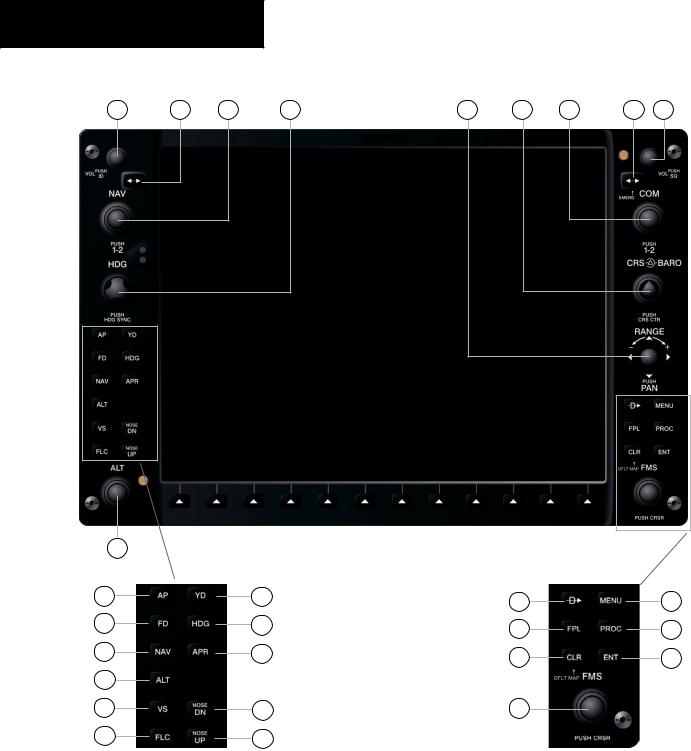
SECTION 1
SYSTEM OVERVIEW
1.1PFD/MFD CONTROLS
1 |
2 |
3 |
4 |
5 |
6 |
7 |
8 |
9 |
17 |
Figure 1-3 |
PFD/MFD Controls |
|
18 |
24 |
10 |
14 |
|
|
||
19 |
25 |
11 |
15 |
20 |
26 |
12 |
16 |
21 |
|
|
|
22 |
27 |
13 |
|
23 |
28 |
|
|
MFD Only
1-2 |
Garmin G1000 Cockpit Reference Guide for the Beechcraft 58/G58 |

Functionality of the PFD and MFD controls are the same with the exception of the dedicated autopilot keys located only on the MFD bezel.
(1)NAV VOL/ID Knob – Controls the NAV audio level. Press to toggle the Morse code identifier ON and OFF. Volume level is shown in the field as a percentage.
(2)NAV Frequency Toggle Key – Toggles the standby and active NAV frequencies.
(3)Dual NAV Knob – Tunes the MHz (large knob) and kHz (small knob) standby frequencies for the NAV receiver. Press to toggle the tuning cursor (light blue box) between the NAV1 and NAV2 fields.
(4)Heading Knob – Turn to manually select a heading on the HSI. When pressed, it synchronizes the heading
bug with the compass lubber line. Selected Heading providestheheadingreferencetotheFlightDirectorwhile operating in Heading Select mode.
(5)Joystick – Changes the map range when rotated. Activates the map pointer when pressed.
(6)CRS/BARO Knob–Thelarge knobsetsthealtimeter barometric pressure and the small knob adjusts the course. The course is only adjustable when the HSI is in VOR1, VOR2, or OBS/SUSP mode. Pressing this knob
centers the CDI on the currently selected VOR. Selected Course provides course reference to the Flight Director when operating in Navigation and Approach modes.
(7)Dual COM Knob – Tunes the MHz (large knob) and kHz (small knob) standby frequencies for the COM transceiver. Pressing this knob toggles the tuning cursor (light blue box) between the COM1 and COM2 fields.
(8)COM Frequency Toggle Key – Toggles the standby and active COM frequencies. Pressing and holding this key for two seconds automatically tunes the emergency frequency (121.5 MHz) in the active frequency field.
(9)COM VOL/SQ Knob – Controls COM audio level. Pressing this knob turns the COM automatic squelch ON and OFF. Audio volume level is shown in the field as a percentage.
SECTION 1
SYSTEM OVERVIEW
(10)Direct-toKey –Allowstheusertoenteradestination waypoint and establish a direct course to the selected destination (specified by the identifier, chosen from the active route, or taken from the map cursor position).
(11)FPL Key – Displays the active Flight Plan Page for creating and editing the active flight plan, or for accessing stored flight plans.
(12)CLR Key (DFLT MAP) – Erases information, cancels an entry, or removes page menus. To display the Navigation Map Page immediately, press and hold CLR (MFD only).
(13)Dual FMS Knob – Used to select the page to be viewed (only on the MFD). The large knob selects a page group (MAP, WPT, AUX, NRST), while the small knob selects a specific page within the page group. Pressing the small knob turns the selection cursor ON and OFF. When the cursor is ON, data may be entered in the different windows using the small and large knobs. The large knob is used to move the cursor on the page, while the small knob is used to select individual characters for thehighlightedcursorlocation. WhentheG1000displays a list that is too long for the display screen, a scroll bar appears along the right side of the display, indicating the availabilityofadditionalitemswithintheselectedcategory. Press the FMS/PUSH CRSR knob to activate the cursor and turn the large FMS knob to scroll through the list.
(14)MENU Key – Displays a context-sensitive list of options. This list allows the user to access additional features, or to make setting changes that relate to certain pages.
(15)PROC Key – Selects approaches, departures and arrivals from the flight plan. If a flight plan is used, available procedures for the departure and/or arrival airport are automatically suggested. If a flight plan is not used,thedesiredairportandthedesiredproceduremaybe selected. This key selects IFR departure procedures (DPs), arrival procedures (STARs) and approaches (IAPs) from the database and loads them into the active flight plan.
Garmin G1000 Cockpit Reference Guide for the Beechcraft 58/G58 |
1-3 |

SECTION 1
SYSTEM OVERVIEW
(16)ENT Key – Accepts a menu selection or data entry. This key is used to approve an operation or complete data entry. Itisalsousedtoconfirmselectionsandinformation entries.
(17)Dual ALT Knob – Sets the reference altitude in the box located above the Altimeter. The large knob selects the thousands, while the small knob selects the hundreds. Selected altitude provides an altitude setting for the Altitude Capture/Hold mode, in addition to the standard G1000 altitude alerter function.
(18)AP Key – Engages/disengages the Autopilot and Flight Director in the default vertical and lateral modes.
(19)FD Key – Activates/deactivates the Flight Director only. Pressing the FD key turns on the Flight Director in the default vertical and lateral modes. Pressing the FD key again deactivates the Flight Director and removes the command bars, unless the Autopilot is engaged. If the Autopilot is engaged, the FD key is disabled.
(20)NAV Key – Selects/deselects the Navigation mode.
(21)ALT Key – Selects/deselects the Altitude Hold
mode.
(22)VS Key – Selects/deselects the Vertical Speed mode.
(23)FLC Key – Selects/deselects the Flight Level Change mode.
(24)YD Key – Engages/disengages the Yaw Damper.
(25)HDG Key – Selects/deselects the Heading Select mode.
(26)APR Key – Selects/deselects the Approach mode.
(27, 28) NOSE UP/NOSE DN Keys – Controls the active pitch reference for the Pitch Hold, Vertical Speed, and Flight Level Change modes.
1.2PFD SOFTKEYS
Softkey ON |
Softkey OFF |
(optional)
|
|
|
|
OBS |
|
CDI |
|
|
XPDR |
|
|
|
NRST |
|
INSET |
|
PFD |
|
|
|
DME |
IDENT |
TMR/REF |
|
ALERTS |
Figure 1-2 PFD Top Level Softkeys
INSET – Press to display the Inset Map in the lower left corner of the PFD.
OFF – Press to remove the Inset Map
DCLTR (3) – Pressmomentarilytoselectthedesired amountofmapdetail. Thedeclutterlevelappears adjacent to the DCLTR softkey.
•Nodeclutter:Allmapfeaturesarevisible
•Declutter–1:Declutterslanddata
•Declutter–2:DeclutterslandandSUAdata
•Declutter–3:DeclutterslargeNAVdataremaining
(removeseverythingexcepttheactiveflightplan) TRAFFIC – Press to display TIS traffic on the map. TOPO – Press to display topographical data (i.e., coastlines, terrain, rivers, lakes, etc.) and
elevation scale on the inset map.
TERRAIN – Press to display terrain information on the inset map.
STRMSCP (optional) – Press to display the Stormscope lightning data on the inset map (within a 200 nm radius of the aircraft).
NEXRAD (optional) – Press to display NEXRAD precititation data on the inset map.
XMLTNG(optional)–PresstodisplaytheXMRadio lightning data on the inset map.
BACK–Presstoreturntothepreviouslevelsoftkey configuration.
PFD – Press to display the additional softkeys for additional configurations to the PFD.
METRIC–Presstodisplaythecurrentandreference altitudes in meters, in addition to feet. Pressing the metric softkey also changes the barometric setting to hectopascals.
DFLTS – Press to reset default settings on the PFD. DME (optional) – Press to display the DME
information window.
1-4 |
Garmin G1000 Cockpit Reference Guide for the Beechcraft 58/G58 |
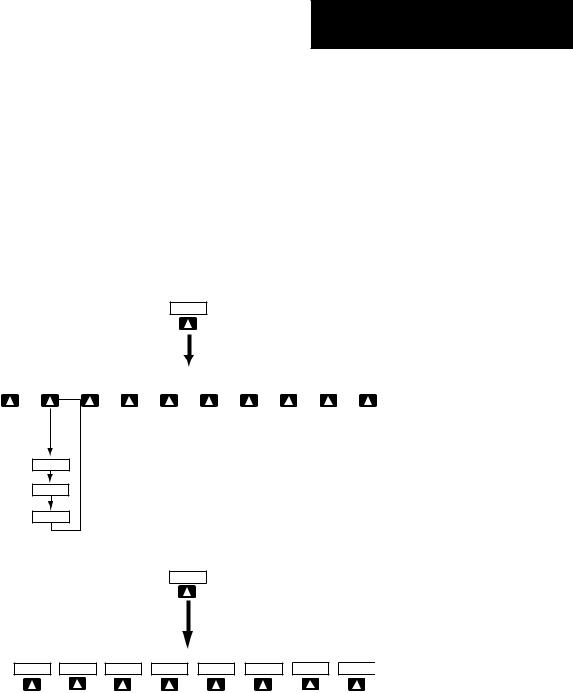
BRG1 (bearing) – Press to cycle through the following information:
NAV1 – Displays NAV1 waypoint frequency or identifier and DME information in the BRG1 information window.
GPS–DisplaysGPSwaypointidentifierandGPS distance information in the BRG1 information window.
OFF – Removes the BRG1 information window.
BRG2 (bearing) – Press to cycle through the following information:
INSET
SECTION 1
SYSTEM OVERVIEW
NAV2 –Displays NAV2 waypoint frequency or identifier and DME information in the BRG2 information window.
GPS–DisplaysGPSwaypointidentifierandGPS distance information in the BRG2 information window.
OFF – Removes the BRG2 information window.
STDBARO–Presstosetthebarometricpressureto 29.92inchesofmercury(1013hPabypressing the METRIC softkey).
BACK – Press to return to the previous level softkeys.
|
|
|
|
|
|
|
|
|
|
(optional) |
(optional) |
|
(optional) |
|
|
|||
|
|
DCLTR |
|
TRAFFIC |
|
|
|
TERRAIN |
|
STRMSCP |
|
NEXRAD |
|
|
|
BACK |
|
ALERTS |
OFF |
|
|
|
TOPO |
|
|
|
|
XM LTNG |
|
|
|||||||
DCLTR-1
DCLTR-2
DCLTR-3
Press the BACK or OFF softkey to return to the top level softkeys
Figure 1-3 PFD Softkey Flow Chart – 1
PFD
|
|
(optional) |
|
|
|
|
|
METRIC |
DFLTS |
DME |
BRG1 |
BRG2 |
STD BARO |
BACK |
ALERTS |
Press the DFLTS softkey to change the PFD metric values to standard
Press the STD BARO or BACK softkeys to return to the top level softkeys
Figure 1-4 PFD Softkey Flow Chart – 2
Garmin G1000 Cockpit Reference Guide for the Beechcraft 58/G58 |
1-5 |
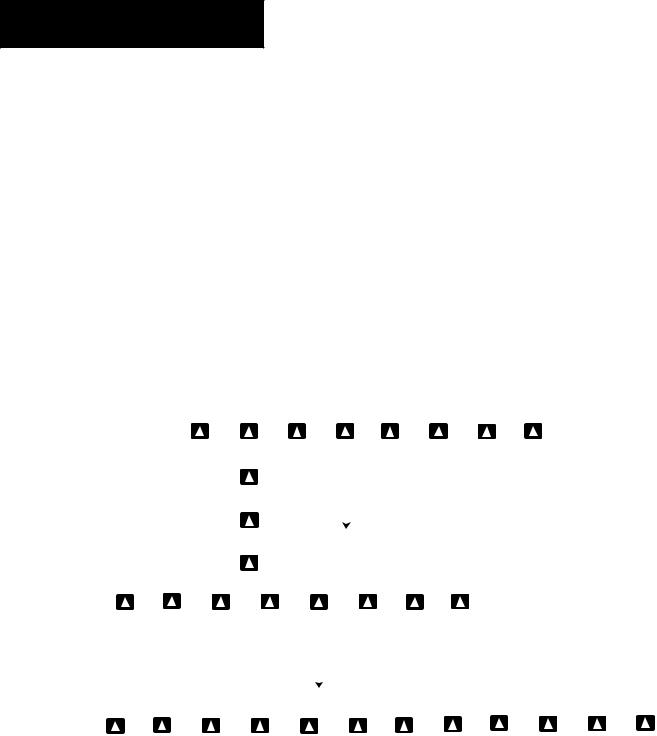
SECTION 1
SYSTEM OVERVIEW
OBS – Press to select OBS mode on the CDI when navigating by GPS (only available with active leg).
CDI – Press to change navigation mode on the CDI between GPS, VOR1 and VOR2.
DME (optional) – Press to display the DME Tuning window.
XPDR – Press to display the transponder mode selection softkeys.
STBY – Press to select standby mode. ON – Press to select mode A.
ALT – Press to select altitude reporting mode. VFR – Press to automatically squawk 1200 (only
in the U.S.A., refer to ICAO standards for VFR codes in other countries).
CODE – Press to display transponder code selection softkeys 0-7.
0 through 7 – Press numbers to enter code.
IDENT – Press to provide special aircraft position identification to Air Traffic Control (ATC).
BKSP – Press to remove numbers entered one at a time.
BACK – Press to return to the previous level softkeys.
IDENT – Press to provide special aircraft position identification to Air Traffic Control (ATC).
BACK – Press to return to the previous level softkeys.
IDENT – Press to provide special aircraft position identification to Air Traffic Control (ATC).
TMR/REF – Press to display the Timer/References window.
NRST – Press to display the Nearest Airports window.
ALERTS – Press to display the Alerts window.
|
|
|
|
|
|
|
|
|
|
|
|
|
|
|
|
|
|
|
(optional) |
|
|
|
|
|
|
|
|
|
|
|
|
|
|
|
|
|
|
|
|
|
|
|
|
|
|
|
|
|||||
|
|
|
|
|
|
|
|
|
|
|
|
|
|
|
|
|
|
|
|
|
|
|
|
|
XPDR |
|
|
|
|
|
|
|
TMR/REF |
|
|
|
|
|
|
ALERTS |
|
|
|
|
|
|||||||
|
|
|
|
|
|
|
|
OBS |
|
|
|
CDI |
|
|
|
|
DME |
|
|
|
|
|
IDENT |
|
|
|
|
NRST |
|
|
|
|
|
|
|
|||||||||||||||||
|
|
|
|
|
|
|
|
|
|
|
|
|
|
|
|
|
|
|
|
|
|
|
|
|
|
|
|
|
|
|
|
|
|
|
|
|
|
|
|
|
|
|
|
|
|
|
|
|
|
|
|
|
|
|
|
|
|
|
|
|
|
|
|
|
|
|
|
|
|
|
|
|
|
|
|
|
|
|
|
|
|
|
|
|
|
|
|
|
|
|
|
|
|
|
|
|
|
|
|
|
|
|
|
|
|
|
|
|
|
|
|
|
|
|
|
|
|
|
|
|
|
|
|
|
|
|
|
|
|
|
|
|
|
|
|
|
|
|
|
|
|
|
|
|
|
|
|
|
|
|
|
|
|
|
|
|
|
|
|
|
|
|
|
|
|
|
|
|
|
|
CDI (VOR1) |
|
|
|
|
|
|
|
|
|
|
|
|
|
|
|
|
|
|
|
|
|
|
|
|
|
|
|
|
|
|
|
|
|
|
|
|||||
|
|
|
|
|
|
|
|
|
|
|
|
|
|
|
|
|
|
|
|
|
|
|
|
|
|
|
|
|
|
|
|
|
|
|
|
|
|
|
|
|
|
|
|
|
|
|
|
|
|
|
|
|
|
|
|
|
|
|
|
|
|
|
|
|
|
|
|
|
|
|
|
|
|
|
|
|
|
|
|
|
|
|
|
|
|
|
|
|
|
|
|
|
|
|
|
|
|
|
|
|
|
|
|
||
|
|
|
|
|
|
|
|
|
|
|
|
|
|
|
|
|
|
|
|
|
|
|
|
|
|
|
|
|
|
|
|
|
|
|
|
|
|
|
|
|
|
|
|
|
|
|
|
|
|
|
|
|
|
|
|
|
|
|
|
|
|
|
|
|
CDI (VOR2) |
|
|
|
|
|
|
|
|
|
|
|
|
|
|
|
|
|
|
|
|
|
|
|
|
|
|
|
|
|
|
|
|
|
|
|
|
||||
|
|
|
|
|
|
|
|
|
|
|
|
|
|
|
|
|
|
|
|
|
|
|
|
|
|
|
|
|
|
|
Press the BACK softkey |
|
|
|
|
|
|
|
|
|
|
|
||||||||||
|
|
|
|
|
|
|
|
|
|
|
|
|
|
|
|
|
|
|
|
|
|
|
|
|
|
|
|
|
|
|
|
|
|
|
|
|
|
|
|
|
|
|||||||||||
|
|
|
|
|
|
|
|
|
|
|
|
|
|
|
|
|
|
|
|
|
|
|
|
|
|
|
|
|
|
|
|
|
|
|
|
|
|
|
|
|
|
|||||||||||
|
|
|
|
|
|
|
|
|
|
|
|
|
|
|
|
|
|
|
|
|
|
|
|
|
|
|
|
|
|
|
|
|
|
|
|
|
|
|
|
|
|
|||||||||||
|
|
|
|
|
|
|
|
|
|
|
|
|
GPS |
|
|
|
|
|
|
|
|
|
|
|
|
|
|
to return to the top level |
|
|
|
|
|
|
|
|
|
|
|
|||||||||||||
|
|
|
|
|
|
|
|
|
|
|
|
|
|
|
|
|
|
|
|
|
|
|
|
|
|
|
|
|
|
|
softkeys |
|
|
|
|
|
|
|
|
|
|
|
|
|
|
|
||||||
|
|
|
|
|
|
|
|
|
|
|
|
|
|
|
|
|
|
|
|
|
|
|
|
|
|
|
|
|
|
|
|
|
|
|
|
|
|
|
|
|
|
|
|
|
|
|
|
|||||
|
|
|
|
|
|
|
|
|
|
|
|
|
|
|
|
|
|
|
|
|
|
|
|
|
|
|
|
|
|
|
|
|
|
|
|
|
|
|
|
|
|
|
|
|
|
|
|
|
|
|
|
|
|
|
STBY |
|
|
ON |
|
|
ALT |
|
|
VFR |
|
|
CODE |
|
|
|
IDENT |
|
|
BACK |
|
ALERTS |
|
|
|
|
|
|
|
|
|
|
|
||||||||||||||||||
|
|
|
|
|
|
|
|
|
|
|
|
|
|
|
|
|
|
|
|
|
|
|
|
|
|
|
|
|
|
|
|
|
|
|
|
|
|
|
|
|
|
|
|
|
|
|
|
|
Press the BACK |
|||
|
|
|
|
|
|
|
|
|
|
|
|
|
|
|
|
|
|
|
|
|
|
|
|
|
|
|
|
|
|
|
|
|
|
|
|
|
|
|
|
|
|
|
|
|
|
|
|
|
||||
|
|
|
|
|
|
|
|
|
|
|
|
|
|
|
|
|
|
|
|
|
|
|
|
|
|
|
|
|
|
|
|
|
|
|
|
|
|
|
|
|
|
|
|
|
|
|
|
|
softkey |
|
||
|
|
|
|
|
|
|
|
|
|
|
|
|
|
|
|
|
|
|
|
|
|
|
|
|
|
|
|
|
|
|
|
|
|
|
|
|
|
|
|
|
|
|
|
|
|
|
|
|
to return to |
|
||
|
|
|
|
|
|
|
|
|
|
|
|
|
|
|
|
|
|
|
|
|
|
|
|
|
|
|
|
|
|
|
|
|
|
|
|
|
|
|
|
|
|
|
|
|
|
|
|
|
the top level |
|
||
|
|
|
|
|
|
|
|
|
|
|
|
|
|
|
|
|
|
|
|
|
|
|
|
|
|
|
|
|
|
|
|
|
|
|
|
|
|
|
|
|
|
|
|
|
|
|
|
|
softkeys |
|
||
|
|
|
|
|
|
|
|
|
|
|
|
|
|
|
|
|
|
|
|
|
|
|
|
|
|
|
|
|
|
|
|
|
|
|
|
|
|
|
|
|
|
|
|
|
|
|
|
|
|
|||
|
|
|
|
|
|
|
|
|
|
|
|
|
|
|
|
|
|
|
|
|
|
|
|
|
|
|
|
|
|
|
|
|
|
|
|
|
|
|
|
|
|
|
|
|
||||||||
|
|
|
|
1 |
|
|
2 |
|
|
|
3 |
|
|
|
|
|
4 |
|
|
|
|
5 |
|
|
|
|
|
6 |
|
|
|
7 |
|
|
|
IDENT |
|
|
BKSP |
|
BACK |
|
ALERTS |
|||||||||
|
0 |
|
|
|
|
|
|
|
|
|
|
|
|
|
|
|
|
|
|
|
|
|
|
|
|
|
|
|
|
|
|
|||||||||||||||||||||
|
|
|
|
|
|
|
|
|
|
|
|
|
|
|
|
|
|
|
|
Figure 1-5 |
PFD Softkey Flow Chart – 3 |
|
|
|
|
|
|
|
|
|
|
|
||||||||||||||||||||
1-6 |
|
|
|
|
|
|
|
|
|
|
Garmin G1000 Cockpit Reference Guide for the Beechcraft 58/G58 |
|
|
|
|
|||||||||||||||||||||||||||||||||||||
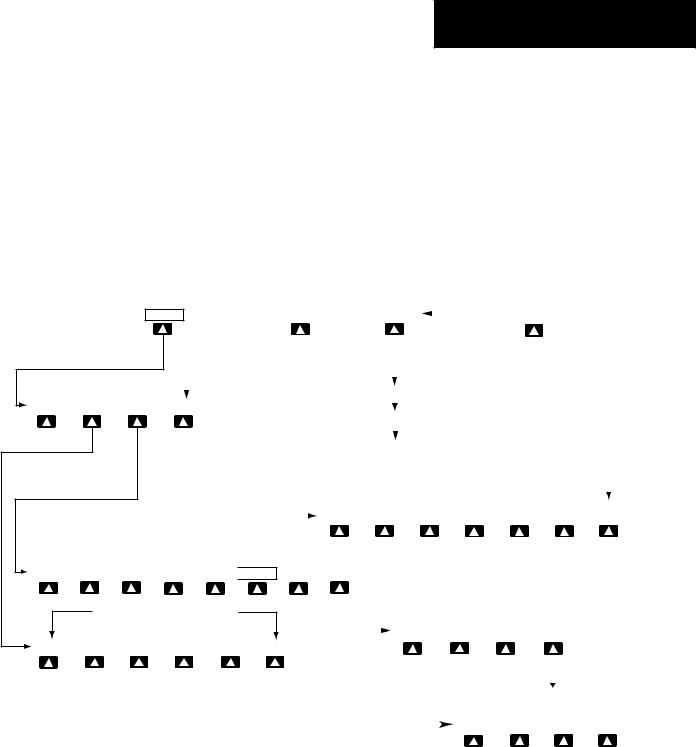
1.3MFD SOFTKEYS
ENGINE–PressingthissoftkeymakesavailabletheLEAN and SYSTEM softkeys which in turn access the Lean Page and the System Page, respectively.
MAP – pressing this softkey enables the following softkeys:
TRAFFIC – pressing this softkey displays/removes Traffic on the Navigation Map.
TOPO – pressing this softkey displays or removes topographic information on the Navigation Map.
TERRAIN – pressing this softkey displays/removes terrain and obstacle data on the Navigation Map.
SECTION 1
SYSTEM OVERVIEW
STRMSCP (optional) – pressing this softkey displays/ removesStormscopelightningdataontheNavigation Map.
NEXRAD (optional) – pressing this softkey displays/ removes precipitation data on the Navigation Map.
XM LTNG (optional) – pressing this softkey displays/ removes XM Radio lightning data on the Navigation Map.
BACK–pressingthissoftkeydisplaystheENGINEand MAP top level softkeys.
DCLTR (declutter) – pressing this softkey removes map information in three levels.
ENGINE
Press the BACK softkey on this level to return to the top softkey level 
ENGINE |
|
LEAN |
|
SYSTEM |
|
BACK |
ENGINE |
|
LEAN |
SYSTEM |
DEC FUEL |
|
INC FUEL |
|
166 GAL |
Press the ENGINE or BACK softkey on any level to return to the default page level
|
MAP |
|
|
|
|
DCLTR |
|
|
|
|
|
|
|
|
|
|
CHKLIST |
|
|
|
|
|
|
|
|
|
||||||||||||
|
|
|
|
|
|
|
|
|
|
|
|
|
|
|
|
|
|
|
|
|
||||||||||||||||||
|
|
|
|
|
|
|
|
|
|
|
|
|
|
|
|
|
|
|
|
|
|
|
|
|
|
|
|
|
|
|
|
|
|
|
|
|
|
|
|
|
|
|
|
|
|
|
|
|
|
|
|
|
|
|
|
|
|
|
|
|
|
|
(optional) |
|
|
|
|
|
|
||||||||
|
|
|
|
|
|
|
|
|
|
|
|
|
|
|
|
|
|
|
|
|
|
|
|
|
|
|
|
|
|
|||||||||
|
|
|
|
|
|
|
|
|
|
|
|
|
|
|
|
|
|
|
|
|
|
|
|
|
|
|
|
|
|
|
|
|
|
|
|
|
||
|
|
|
|
|
|
|
|
|
|
|
|
|
|
|
|
|
|
|
|
|
|
|
|
|
|
|
|
|
|
|
|
|
|
|
|
|
|
|
|
|
|
|
|
|
|
|
|
DCLTR-1 |
|
|
|
|
|
|
|
|
|
|
|
|
|
|
|
|
|
|
|
|
|
|
|
|
|
||||
|
|
|
|
|
|
|
|
|
|
|
|
|
|
|
|
|
|
|
|
|
|
|
|
|
|
|
|
|
|
|
|
|
|
|
|
|
|
|
|
|
|
|
|
|
|
|
|
|
|
|
|
|
|
|
|
|
|
|
|
|
|
|
|
|
|
|
|
|
|
|
|
|
|
|
|
|
|
|
|
|
|
|
|
|
|
|
DCLTR-2 |
|
|
|
|
|
|
|
|
|
|
|
|
|
|
|
|
|
|
|
|
|
|
|
|
|
||||
|
|
|
|
|
|
|
|
|
|
|
|
|
|
|
|
|
|
|
|
|
|
|
|
|
|
|
|
|
|
|
|
|
|
|
|
|
|
|
|
|
|
|
|
|
|
|
|
|
|
|
|
|
|
|
|
|
|
|
|
|
|
|
|
|
|
|
|
|
|
|
|
|
|
|
|
|
|
|
|
|
|
|
|
|
|
|
DCLTR-3 |
|
|
|
|
|
|
|
|
|
|
|
|
|
|
|
|
|
|
|
|
|
|
|
|
|
||||
|
|
|
|
|
|
|
|
|
|
|
|
|
|
|
|
|
|
|
|
|
|
|
|
|
|
|
|
Press to return to the |
|
|||||||||
|
|
|
|
|
|
|
|
|
|
|
|
|
|
|
|
|
|
|
|
|
|
|
|
|
|
|
|
|
||||||||||
|
|
|
|
|
|
|
|
|
|
|
|
|
|
|
|
|
|
|
|
|
|
|
|
|
|
|
|
|
||||||||||
|
|
|
|
|
|
|
|
|
|
|
|
|
|
|
|
|
|
|
(optional) |
|
|
|
|
|
|
top softkey level |
|
|
|
|
||||||||
|
|
|
|
|
|
|
|
|
|
|
|
|
|
|
|
|
|
|
|
(optional) |
|
(optional) |
|
|
|
|
|
|
||||||||||
|
|
|
|
|
TRAFFIC |
|
|
|
TOPO |
|
TERRAIN |
|
STRMSCP |
|
NEXRAD |
|
|
|
|
BACK |
|
|
||||||||||||||||
|
|
|
|
|
|
|
|
|
|
|
|
|
XM LTNG |
|
|
|
||||||||||||||||||||||
|
|
|
|
|
|
|
|
|
|
|
|
|
|
|
|
|||||||||||||||||||||||
|
|
|
|
|
|
|
|
|
|
|
|
|
|
|
|
|
|
|
|
|
|
|
|
|
|
|
|
|
|
|
|
|
|
|
|
|||
|
194 GAL |
|
BACK |
|
|
|
|
|
|
|
|
|
|
|
|
|
|
|
|
|
|
|
|
|
|
|
|
|
|
|
|
|
|
|
|
|||
|
|
|
|
|
|
|
|
|
|
|
|
|
|
|
|
|
The DONE softkey changes to UNDO when the checklis |
|||||||||||||||||||||
|
|
|
|
|
|
|
|
|
|
|
|
|
|
|
|
|
item is already checked |
|
|
|
|
|
|
|
|
|
|
|
||||||||||
|
|
|
|
|
|
|
|
|
|
|
|
|
|
|
|
|
|
|
|
|
|
|
|
|
|
|
|
|
|
|
|
|||||||
|
|
|
|
|
|
|
|
|
|
|
ENGINE |
|
|
DONE |
|
|
EXIT |
|
|
EMERGCY |
|
|
|
|
|
|
|
|
||||||||||
|
|
|
|
|
|
|
|
|
|
|
|
|
|
|
|
|
|
|
|
|
|
|
|
|
|
|||||||||||||
ENGINE |
|
LEAN |
|
SYSTEM |
|
CYL SLCT |
|
ASSIST |
|
BACK |
|
|
|
|
|
|
|
|
|
|
|
|
|
|
|
|
|
|
|
|
|
|
|
|
|
|
|
|
|
|
|
|
|
|
|
|
|
|
|
CLR |
|
|
|
|
|
|
|
|
|
|
|
|
|
|
|
|
|
|
|
|
|
|
|
ENGINE |
|
|
MAP |
|
DCLTR |
|
CHKLIST |
|
|||
Figure 1-6 MFD Softkeys |
|
|
|
|
|
|
|
|
|
|
||||
Garmin G1000 Cockpit Reference Guide for the Beechcraft 58/G58 |
|
|
|
|
1-7 |
|||||||||
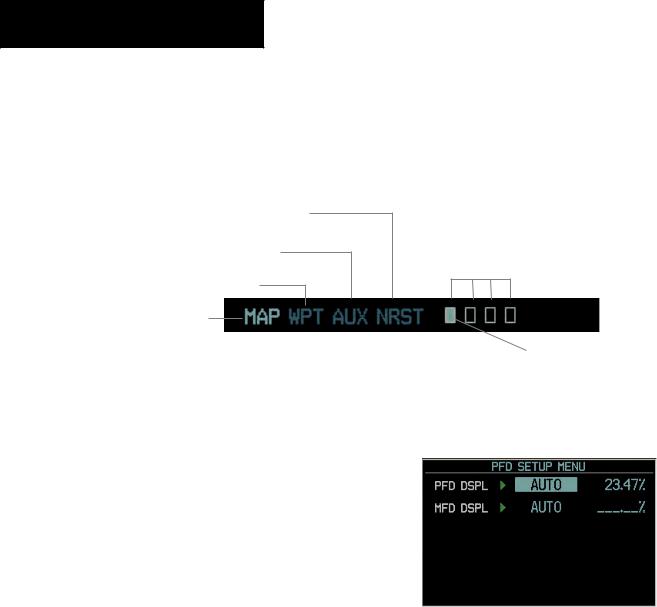
SECTION 1
SYSTEM OVERVIEW
1.4MFD PAGE GROUPS
1.Turn the large FMS knob until the desired page group is selected.
2.Turn the small FMS knob to select pages within the group. See Figure 1-7.
Nearest Group
Auxiliary Page Group
Waypoint Page Group
Map Page Group
Number of Pages in Current
Group
Figure 1-7 Page Group Icon |
Selected Page |
1.5BACKLIGHTING
To manually adjust the backlight for the
PFD and MFD:
1.Press the MENU key on the PFD to display the PFD Setup Menu window.
2.PressthesmallFMSknobtoactivatethecursor. ‘PFD DSPL > AUTO’ is now highlighted.
3.Turn the small FMS knob to display the selection window.
4. Turn the FMS knob to select ‘MANUAL’, then |
Figure 1-8 PFD Setup Menu Window |
press the ENT key. |
|
5.With the intensity value now highlighted, turn the small FMS knob to select the desired backlighting.
6.Turn the large FMS knob to highlight ‘MFD DSPL > AUTO’ and repeat steps 3 through 5.
1-8 |
Garmin G1000 Cockpit Reference Guide for the Beechcraft 58/G58 |
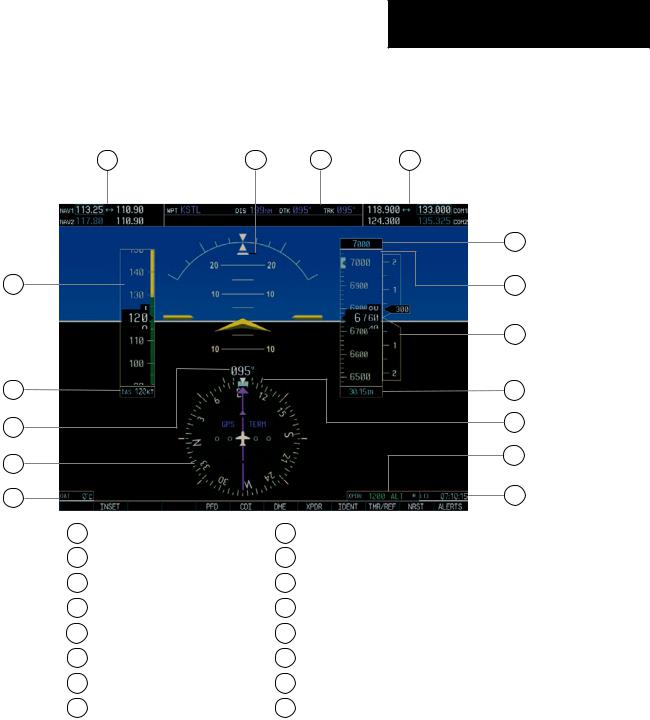
SECTION 2
FLIGHT INSTRUMENTS
SECTION 2: FLIGHT INSTRUMENTS
ThefollowingdiscussionspertaintothePrimaryFlight
Display, unless otherwise indicated.
1 |
16 |
15 |
14 |
|
13 |
2 |
12 |
|
11 |
3 |
10 |
4 |
9 |
|
|
5 |
8 |
|
|
6 |
7 |
1 |
NAV Frequency Window |
9 |
Turn Rate Indicator |
|
2 |
Airspeed Indicator |
10 |
Barometric Setting Box |
|
3 |
True Airspeed Box |
11 |
Vertical Speed Indicator |
|
4 |
Heading Box |
12 |
Altimeter |
|
5 |
Horizontal Situation Indicator |
13 |
Altitude Reference Box |
|
6 |
Outside Air Temperature Box |
14 |
COM Frequency Window |
|
7 |
System Time Box |
15 |
Navigation Status Bar |
|
8 |
Transponder Status Bar |
16 |
Slip/Skid Indicator |
|
|
Figure 2-1 Default PFD Information |
|
||
|
Garmin G1000 Cockpit Reference Guide for the Beechcraft 58/G58 |
2-1 |
||
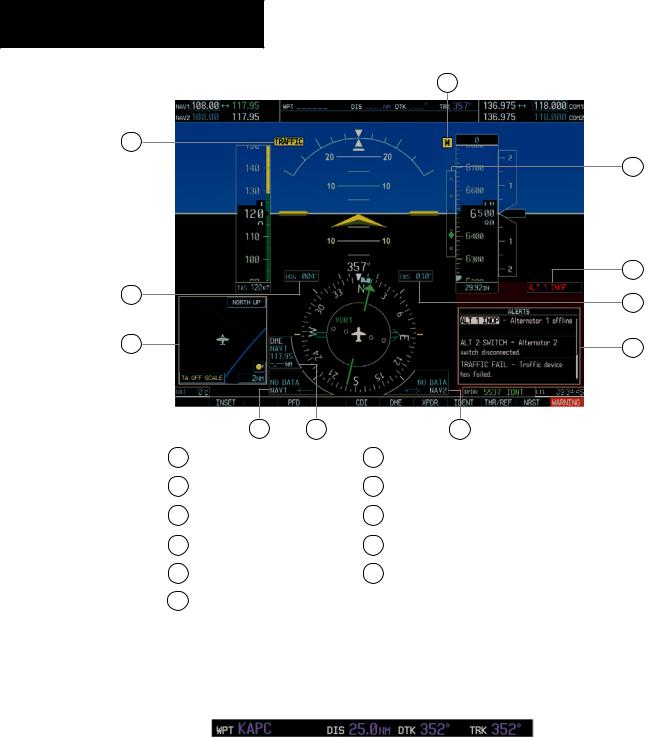
SECTION 2
FLIGHT INSTRUMENTS
11
1
2
3
|
4 |
5 |
|
6 |
1 |
Traffic Annunciation |
|
7 |
Alerts Window |
2 |
Selected Heading Box |
|
8 |
Selected Course Box |
3 |
Inset Map |
|
9 |
Annunciation Window |
4 |
BRG1 Information Window |
10 |
Vertical Deviation/Glideslope Indicator |
|
5 |
DME Information Window |
11 |
Marker Beacon Annunciation |
|
6BRG2 Information Window
Figure 2-2 Additional PFD Information
|
Distance to Next Waypoint |
|
|
Desired Track to |
|
||||
|
|
|
Next Waypoint |
Current Track |
|||||
|
|
|
|||||||
|
Next Waypoint |
|
|
|
|
|
|
|
|
|
|
|
|
|
|
|
|
|
|
|
|
|
|
|
|
|
|
|
|
|
|
|
Figure 2-3 |
PFD Navigation Status Window (default) |
|
||||
2-2 |
|
Garmin G1000 Cockpit Reference Guide for the Beechcraft 58/G58 |
|||||||
10
9
8
7

2.1AIRSPEED INDICATOR
|
|
|
|
|
Flap Extension |
|
|
|
|
|
|
||
|
|
|
|
|
|
Speed |
|
|
|
|
|
|
Airspeed Trend |
|
|
|
|
|
|
|
Actual Airspeed |
|
|
|
|
|
Vector |
|
||||||
Speed Range |
|
|
|
|
Vspeed |
|
|
|
|
|
|||
(flaps 30 speed range) |
|
|
|
|||
|
|
|
References |
|||
|
|
|
|
|
|
|
True Airspeed |
|
|
|
(best glide) |
||
|
|
|
|
|||
Box |
|
|
|
|
|
|
Figure 2-4 Airspeed Indicator |
||||||
Speed Indication |
|
|
|
|
||
The indicated airspeed is displayed inside the black pointer. The pointer will become red upon reaching Vne.
Figure 2-5 Red Pointer at Vne
Speed Ranges
The color coded speed range strip denotes flaps operating range, normal operating range, and never exceed speed (Vne). A red range is also present for low speed awareness. Refer to the Pilot’s Operating Handbook (POH) for airspeed limitations and indicator markings.
Airspeed Trend Vector
The end of the trend vector displays approximately what the airspeed will be in 6 seconds if the current rate of acceleration/deceleration is maintained.
SECTION 2
FLIGHT INSTRUMENTS
Vspeed References
Vspeed References are turned on or off in the Timer/References window. Press the TMR/REF softkey to display the widow. When active (ON), the Vspeeds are displayed at their respective locations to the right of the airspeed scale. To activate the Vspeed References, display the Timer/Reference window and turn the large FMS knob to place the cursor in the ON/OFF field. Turn the small FMS knob to select ON or OFF.
2.2ATTITUDE INDICATOR
TheSlip/SkidIndicatorislocatedundertherollpointer and moves laterally away from the pointer to indicate lateral acceleration. One Slip/Skid indicator displacement is equal to one ball displacement when compared to a traditional slip/skid indicator.
|
10 |
|
|
1 |
|
|
9 |
|
|
|
|
2 |
|
|
8 |
|
|
|
|
3 |
|
|
7 |
|
|
|
|
|
|
|
6 |
4 |
|
|
|
|
|
|
5 |
1 |
Roll Pointer |
6 |
Aircraft Wing Tips |
2 |
Roll Scale |
7 |
Pitch Scale |
3 |
Horizon Line |
8 |
Slip/Skid Indicator |
4 |
Aircraft Symbol |
9 |
Sky Representation |
5 |
Land Representation |
10 |
Roll Index |
Figure 2-6 Attitude Indicator
Garmin G1000 Cockpit Reference Guide for the Beechcraft 58/G58 |
2-3 |
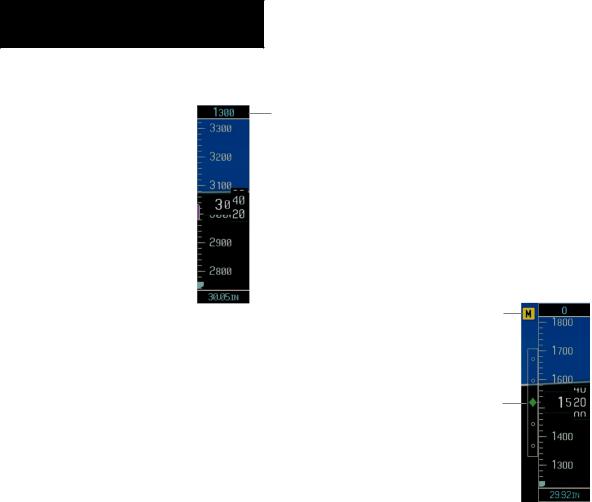
SECTION 2
FLIGHT INSTRUMENTS
2.3ALTIMETER
Altitude Reference
Box
Altitude Trend |
|
Current Altitude |
||
|
||||
Vector |
|
|
|
|
Altitude Reference Bug |
|
|
|
Barometric Setting |
|
|
|
||
|
|
|
|
|
|
|
|
|
Box |
|
Figure 2-7 Altimeter |
|||
Altitude Reference Bug
The Altitude Reference Bug can be set to any desired altitude. The bug acts as a visual reference to indicate the Altitude Select setting.
To set the altitude reference bug:
1.Turn the ALT knobs to set the altitude reference bug. The smallALT knob sets the hundreds and the large ALT knob sets the thousands. This altitude also appears in the altitude reference box above the altimeter.
Altitude Trend Vector
The end of the trend vector displays approximately what the altitude will be in 6 seconds if the current rate of vertical speed is maintained.
Barometric Setting Box
To set barometric pressure, turn the BARO knob to select the desired setting.
2.4VERTICAL DEVIATION/GLIDESLOPE INDICATOR
The Vertical Deviation/Glideslope Indicator appears when an ILS is tuned in the active NAV field.
2.5MARKER BEACON ANNUNCIATIONS
Marker Beacon
Annunciation
Vertical
Deviation/Glideslope
Indicator
Figure 2-8 Marker Beacon and Vertical Deviation
2-4 |
Garmin G1000 Cockpit Reference Guide for the Beechcraft 58/G58 |
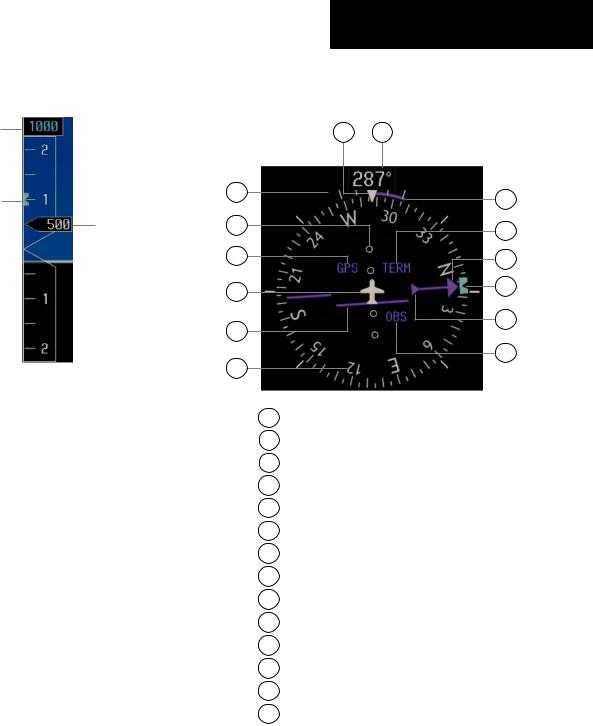
2.6VERTICAL SPEED INDICATOR
Selected Vertical Speed
Vertical Speed Bug
Vertical Speed Pointer
Figure 2-9 Vertical Speed Indicator
The actual vertical speed is displayed inside the pointer.
PressingtheVSkeywilldisplaytheVerticalSpeedBug. Press the NOSE UP or NOSE DN key to adjust.
SECTION 2
FLIGHT INSTRUMENTS
2.7HORIZONTAL SITUATION INDICATOR (HSI)
14 |
13 |
1 |
12 |
|
|
2 |
11 |
|
|
3 |
10 |
4 |
9 |
|
|
5 |
8 |
|
|
6 |
7 |
|
1Turn Rate Indicator
2Lateral Deviation Scale
3Navigation Source
4Aircraft Symbol
5Course Deviation Indicator
6Rotating Compass Rose
7OBS Mode
8TO/FROM Indicator
9 Heading Bug
10Course Pointer
11Flight Phase
12Turn Rate and Heading Trend Vector
13Heading
14Lubber Line
Figure 2-10 Horizontal Situation Indicator
Garmin G1000 Cockpit Reference Guide for the Beechcraft 58/G58 |
2-5 |

SECTION 2
FLIGHT INSTRUMENTS
Turn Rate Indicator and Heading Trend Vector
Each tick mark is at 9 (half standard rate tick mark) and 18 (standard rate tick mark) degrees to the left and right of the lubber line. A wide magenta line displays the current turn rate, up to 24 degrees. A magenta arrowhead appearsat25degrees. Thistrendvectorprovidesthepilot with a prediction of what the heading will be in 6 seconds at the present turn rate.
Figure 2-14 Turn Rate Indicator and Heading Trend Vector
Course Pointer
The course pointer is a single line arrow (GPS, VOR1 andLOC1)ordoublelinearrow(VOR2andLOC2)which points in the direction of the set course.
Figure 2-15 Course Pointer
Bearing Pointers and Information Windows
Pressing the PFD softkey provides access to the BRG1 and BRG2 softkeys. The BRG1 pointer is a single line pointer. The BRG2 pointer is a double line pointer.
DME |
Bearing 1 |
Bearing 2 |
|
|
||||
Information |
CDI |
|||||||
Window |
Pointer |
Pointer |
||||||
|
|
|
|
|
|
|
|
|
|
|
|
|
|
|
|
|
|
|
|
|
|
|
|
|
|
|
|
|
|
|
Bearing 1 |
Bearing 2 |
||
Information |
Information |
||
Window |
Window |
||
Figure 2-14 HSI with Bearing Information
Distance to
Bearing Source
Waypoint
Identifier
Bearing Pointer
Source Icon
Figure 2-15 BRG1 Information Window
Course Deviation Indicator (CDI)
The CDI scale automatically adjusts to the current phase of flight (enroute 5.0 nm, terminal area 1.0 nm, or approach 0.3 nm). Scaling may be selected manually from the MFD System Setup Page. See the MFD Pilot’s Guide for more detail.
Distance to
Bearing Source
Waypoint
Identifier
|
|
|
|
Pointer |
Bearing |
||
Icon |
Source |
||
|
Figure 2-16 BRG2 Information Window |
2-6 |
Garmin G1000 Cockpit Reference Guide for the Beechcraft 58/G58 |
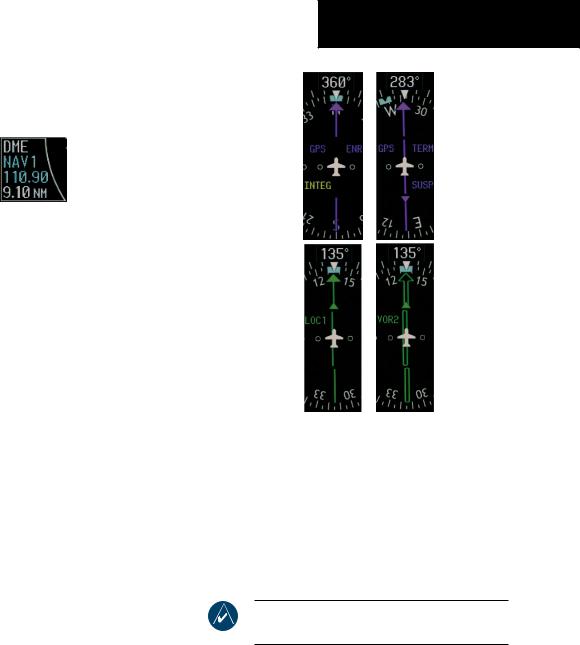
DME Radio (optional)
To display the DME Information Window, press the PFD softkey followed by the DME softkey.
Figure 2-17 DME Information Window
Navigation Source
To change between navigation sources:
1.Press the CDI softkey to change from GPS to VOR1/LOC1.
2.Press the CDI softkey again to change from VOR1/LOC1 to VOR2/LOC2.
3.Press the CDI softkey a third time to return to GPS.
WhenusingGPSasthenavigationsource,thefollowing may appear:
•INTEG – RAIM is not available
•WARN – GPS detects a position error
•SUSP – Displayed when in OBS Mode indicating GPS navigation is suspended.
SECTION 2
FLIGHT INSTRUMENTS
Figure 2-18 GPS INTEG, GPS SUSP, LOC1 and VOR2
To enable/disable OBS mode while navigating with GPS:
1.Press the OBS softkey to select OBS Mode.
2.Turn the CRS knob to select the desired course TO/FROM the waypoint.
3.Pressthe OBS softkeyagaintoreturntonormal operation.
NOTE: The OBS softkey is only displayed when navigating an active leg.
Garmin G1000 Cockpit Reference Guide for the Beechcraft 58/G58 |
2-7 |

SECTION 2
FLIGHT INSTRUMENTS
.
This page intentionally left blank.
2-8 |
Garmin G1000 Cockpit Reference Guide for the Beechcraft 58/G58 |

SECTION 3: ENGINE INDICATION
SYSTEM (EIS)
3.1ENGINE DISPLAY
In all cases green indicates normal operation, yellow indicates caution, and red indicates warning.
Pressing the ENGINE softkey makes available the LEANandSYSTEMsoftkeyswhichinturnprovideaccess to the Lean Page and the System Page, respectively.
Manifold
Pressure
Gauge (Left Engine)
RPM Gauge
(Left Engine) Propeller Sync
Indicator
Fuel Flow
Numeric
Fuel Flow Readout
Indicator
Cylinder Head
Temperature
Oil Temperature Indicator
Indicator
Oil Pressure
Indicator
Ammeter
Fuel Quantity
Indicator
Figure 3-1 Default Engine Page
SECTION 3 – ENGINE
INDICATION SYSTEM (EIS)
3.2LEAN ENGINE DISPLAY
|
|
|
Difference between peak |
|
Cylinder peak |
and current temperature |
|||
|
of selected cylinder |
|||
|
||||
temperature |
|
(Right Engine) |
||
(Left Engine) |
|
|
|
|
Exhaust Gas |
|
|
EGT Readout |
|||
Temperature |
|
|
||||
|
|
For Selected |
||||
Bar Graphs |
|
|
||||
|
|
|
|
Cylinder |
||
(Left Engine) |
|
|
|
|
||
|
|
(Right Engine) |
||||
Cylinder Head |
|
|
||||
|
|
|
|
CHT Readout |
||
Temperature |
|
|
|
|
|
|
|
|
|
|
For Selected |
||
Bar Graphs |
|
|
|
|
||
|
|
|
|
Cylinder |
||
(Left Engine) |
|
|
|
|
||
|
|
|
|
(Right Engine) |
||
|
|
|
|
|
|
|
Figure 3-2 LEAN Engine Page |
||||||
Press the CYL SLCT softkey to select the desired cylinder for monitoring.
The CYL SLCT softkey becomes disabled when the ASSIST softkey is pressed.
Pressing the ASSIST softkey causes the first cylinder that peaks to become highlighted and information for that cylinder to be displayed.
Garmin G1000 Cockpit Reference Guide for the Beechcraft 58/G58 |
3-1 |
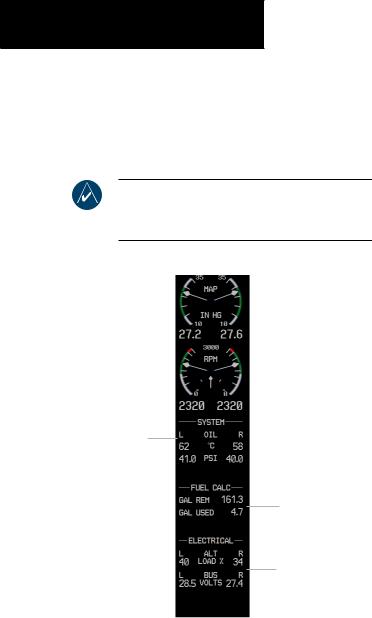
SECTION 3 – ENGINE
INDICATION SYSTEM (EIS)
3.3ENGINE SYSTEM DISPLAY
If desired, use the DEC FUEL, INC FUEL, 166 GAL, and 194 GAL softkeys to adjust the amount of fuel remaining for totalizer calculations.
NOTE: Fuel calculations do not use the aircraft fuel quantity indicators, and are calculated from the last time the fuel was reset.
System
Information
Fuel Calculation
Information
Electrical
Information
Figure 3-3 SYSTEM Engine Page
3-2 |
Garmin G1000 Cockpit Reference Guide for the Beechcraft 58/G58 |
